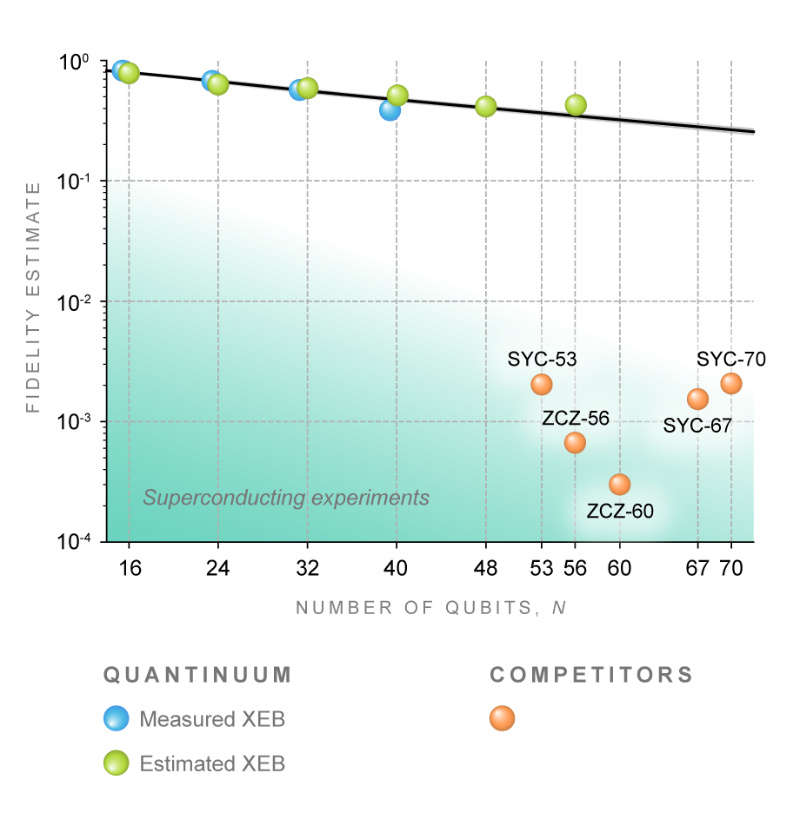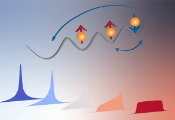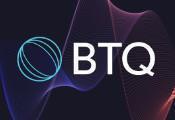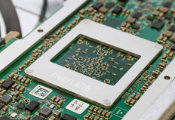Quantinuum’s H-Series Hits 56 Physical Qubits That Are All-to-All Connected, and Departs the Era of Classical Simulation
June 5, 2024 -- Quantinuum’s H-Series combines full scalability with market-leading fidelity, performance, and error correction capabilities. In a demonstration with JPMorgan Chase & Co., Quantinuum’s H2-1 with 56 qubits achieved a massive uplift in an iconic demonstration.
The quantum computing industry is departing the era when quantum computers could be simulated by a classical computer. Today, we are making two milestone announcements. The first is that our H2-1 processor has been upgraded to 56 trapped-ion qubits, making it impossible to classically simulate, without any loss of the market-leading fidelity, all-to-all qubit connectivity, mid-circuit measurement, qubit reuse, and feed forward.
The second is that the upgrade of H2-1 from 32 to 56 qubits makes our processor capable of challenging the world’s most powerful supercomputers. This demonstration was achieved in partnership with our long-term collaborator JPMorgan Chase & Co. and researchers from Caltech and Argonne National Lab.
Our collaboration tackled a well-known algorithm, Random Circuit Sampling (RCS), and measured the quality of our results with a suite of tests including the linear cross entropy benchmark (XEB) – an approach first made famous by Google in 2019 in a bid to demonstrate “quantum supremacy”. An XEB score close to 0 says your results are noisy – and do not utilize the full potential of quantum computing. In contrast, the closer an XEB score is to 1, the more your results demonstrate the power of quantum computing. The results on H2-1 are excellent, revealing, and worth exploring in a little detail.
Our results show how far quantum hardware has come since Google’s initial demonstration. They originally ran circuits on 53 superconducting qubits that were deep enough to severely frustrate high-fidelity classical simulation at the time, achieving an estimated XEB score of ~0.002. While they showed that this small value was statistically inconsistent with zero, improvements in classical algorithms and hardware have steadily increased what XEB scores are achievable by classical computers, to the point that classical computers can now achieve scores similar to Google’s on their original circuits.

In contrast, we have been able to run circuits on all 56 qubits in H2-1 that are deep enough to challenge high-fidelity classical simulation while achieving an estimated XEB score of ~0.35. This >100x improvement implies the following: even for circuits large and complex enough to frustrate all known classical simulation methods, the H2 quantum computer produces results without making even a single error about 35% of the time. In contrast to past announcements associated with XEB experiments, 35% is a significant step towards the idealized 100% fidelity limit in which the computational advantage of quantum computers is clearly in sight.
This is a vitally important moment for companies and governments watching this space and deciding when to invest in quantum: these results underscore both the performance capabilities and the rapid rate of improvement of our processors, especially the System Model H2, as a prime candidate for achieving near-term value.
A direct comparison can be made between the time it took H2-1 to perform RCS and the time it took a classical supercomputer. However, classical simulations of RCS can be made faster by building a larger supercomputer (or by distributing the workload across many existing supercomputers). A more robust comparison is to consider the amount of energy that must be expended to perform RCS on either H2-1 or on classical computing hardware, which ultimately controls the real cost of performing RCS. An analysis based on the most efficient known classical algorithm for RCS and the power consumption of leading supercomputers indicates that H2-1 can perform RCS at 56 qubits with an estimated 30,000x reduction in power consumption. These early results should be seen as very attractive for data center owners and supercomputing facilities looking to add quantum computers as “accelerators” for their users.
Today’s milestone announcements are clear evidence that the H2-1 quantum processor can perform computational tasks with far greater efficiency than classical computers. They underpin the expectation that as our quantum computers scale beyond today’s 56 qubits to hundreds, thousands, and eventually millions of high-quality qubits, classical supercomputers will quickly fall behind. Quantinuum’s quantum computers are likely to become the device of choice as scrutiny continues to grow of the power consumption of classical computers applied to highly intensive workloads such as simulating molecules and material structures – tasks that are widely expected to be amenable to a speedup using quantum computers.
With this upgrade in our qubit count to 56, we will no longer be offering a commercial “fully encompassing” emulator – a mathematically exact simulation of our H2-1 quantum processor is now impossible, as it would take up the entire memory of the world’s best supercomputers. With 56 qubits, the only way to get exact results is to run on the actual hardware, a trend the leaders in this field have already embraced.
More generally, this work demonstrates that connectivity, fidelity, and speed are all interconnected when measuring the power of a quantum computer. Our competitive edge will persist in the long run; as we move to running more algorithms at the logical level, connectivity and fidelity will continue to play a crucial role in performance.




































